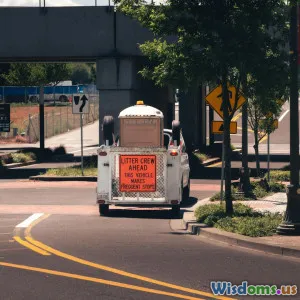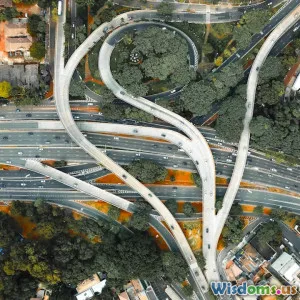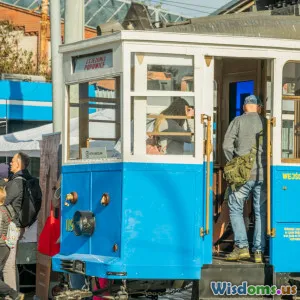
5 Surprising Ways AI Is Changing Everyday Urban Transportation
8 min read Explore 5 unexpected ways AI is revolutionizing urban transportation, making city travel smarter, safer, and more sustainable every day. (0 Reviews)
5 Surprising Ways AI Is Changing Everyday Urban Transportation
Urban transportation has always been the lifeline of a city’s heartbeat. Every day, millions of people navigate through traffic, public transit, and shared mobility services to reach their destinations. While traffic jams, delays, and accidents have historically defined this daily commute, something extraordinary is reshaping these experiences—Artificial Intelligence (AI). Beyond the commonly discussed use of AI in driverless cars, AI’s influence on urban mobility is far broader and compelling than many realize. Let's delve into five surprising ways AI is revolutionizing how we move around cities.
1. Smart Traffic Lights That Learn and Adapt
Traditional traffic lights operate on fixed timers or basic sensors, often inefficiently managing flow and contributing to congestion. AI changes this by enabling adaptive traffic signals that learn from real-time road conditions.
Using computer vision and machine learning, AI systems analyze patterns of vehicles, pedestrians, and public transit at intersections. In Pittsburgh, for example, a deployment of Carnegie Mellon University’s Surtrac system reduced travel times by up to 25% and wait times at intersections by 40%. The system continuously adjusts light cycles dynamically, prioritizing heavy traffic flows or emergency vehicles when needed.
This technology not only cuts down idle times and fuel consumption but also reduces urban air pollution — a major contributor to health problems in cities worldwide.
2. Predictive Maintenance for Public Transit Infrastructure
Public transit reliability often hinges on the timely maintenance of vehicles and infrastructure. AI algorithms are now revolutionizing preventive maintenance by predicting when buses, trains, or even the power grid supporting subways need servicing.
For instance, Transport for London (TfL) partners with AI analytics companies to predict failures in its New Tube for London fleet. By analyzing sensor data, AI forecasts component wear and potential failures before they occur, preventing costly breakdowns and service delays.
This proactive approach increases vehicle uptime and safety while saving transit agencies millions annually, illustrating AI’s immense potential to improve urban transport indirectly yet profoundly.
3. Personalized Multimodal Travel Planning
Getting from Point A to Point B in a big city can be complex, involving buses, trains, bike shares, or e-scooters. AI-powered platforms are now easing this process by creating personalized, real-time, multimodal travel plans.
Apps like Moovit and Citymapper use AI to analyze all available transport options, factoring in departure times, delays, ticketing options, and even user preferences. For example, a commuter might get suggestions combining subway, bike-share, and ride-hailing services to minimize time and cost.
These smart navigators can reduce daily commuting stress and carbon footprints by making public or shared transport more accessible and convenient, thus encouraging sustainable urban mobility.
4. Enhancing Safety with AI-Driven Surveillance and Incident Detection
Urban transportation safety is a priority, and AI is now pivotal in enhancing it beyond human capabilities.
AI-powered cameras on buses, trams, and transit hubs monitor crowds and traffic, detecting dangerous situations like accidents, overcrowding, or suspicious behavior in real time. Cities, such as Singapore, utilize AI algorithms to assess dashcam footage and identify hazardous driving behaviors, alerting authorities swiftly.
Moreover, AI-driven collision avoidance systems in buses and delivery vehicles alert drivers or autonomously activate brakes, significantly reducing accidents. According to a study by the National Highway Traffic Safety Administration (NHTSA), such advanced driver-assistance systems (ADAS) could prevent up to 7% of urban crashes.
By increasing situational awareness and promoting proactive interventions, AI helps create safer urban transportation environments.
5. AI in Autonomous Last-Mile Delivery and Micro-Mobility
Last-mile delivery—the final step of transport from a distribution hub to the customer’s door—is crucial in urban logistics but challenging due to traffic and parking constraints.
AI is fueling the growth of autonomous delivery robots and drones that navigate sidewalks and bike lanes efficiently. Companies like Starship Technologies have deployed AI-guided robots in cities like Washington D.C. and London that complete deliveries while minimizing human contact, an innovation accelerated by the pandemic.
Simultaneously, AI optimizes fleets of electric scooters and bikes by predicting demand hotspots, repositioning vehicles, and minimizing downtime, enhancing shared micro-mobility systems' efficiency and sustainability.
These AI-driven logistics and micro-mobility advancements reduce urban congestion, pollution, and delivery time, signifying a paradigm shift in urban transportation.
Conclusion
AI is silently rewriting the rulebook of urban transportation in remarkably diverse and surprising ways. From intelligent traffic lights that think on their feet to predictive maintenance keeping buses moving, personalized travel planners easing commutes, AI-enhanced safety systems saving lives, and autonomous last-mile deliveries making urban logistics smarter—each development interweaves technology with human-centric urban mobility.
As cities grow and transportation demands intensify, embracing these AI innovations is no longer optional but essential. Stakeholders including city planners, policymakers, transit agencies, and citizens must foster regulations, infrastructure, and ecosystems that support AI-driven transition.
For urban dwellers, understanding and supporting these technologies opens pathways to safer, faster, cleaner, and more convenient transportation experiences. The AI-driven future of urban transportation is here and rich with promise—it’s time we take notice and ride along.
References
- Surtrac Adaptive Traffic Signal Control by Carnegie Mellon University: https://news.cmu.edu/releases/surtrac-adaptive-traffic-control
- Transport for London predictive maintenance program: https://tfl.gov.uk/
- National Highway Traffic Safety Administration studies on ADAS: https://www.nhtsa.gov/
- Starship Technologies urban delivery robots: https://www.starship.xyz/
- Moovit and Citymapper AI-based travel planning apps: https://www.moovitapp.com/, https://citymapper.com/
Rate the Post
User Reviews
Popular Posts


















